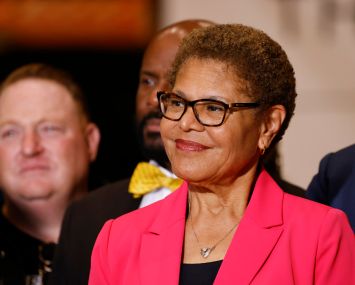Construction Labor Shortage’s Newest Culprits? Deportations and Inflation
9 in 10 construction firms report trouble filling salaried roles
By Amanda Schiavo April 4, 2025 6:00 am
reprints
Deportations and inflation are worsening a labor shortage that was already running rampant through the construction industry, hindering projects and adding to an already significant affordable housing crisis across the country.
A 2024 workforce study found that 92 percent of construction firms with open positions for salaried workers had trouble filling those jobs, according to trade group the Associated General Contractors of America and technology firm Arcoro, a jump from the 85 percent recorded in a 2023 survey. Additionally, this year the industry will need to add 454,000 new workers on top of its typical hiring if construction demands are to be met, according to the Associated Builders and Contractors labor union.
“The single biggest problem” in the construction industry is the lack of skilled workers, said Gregory Kraut, co-founder and CEO of owner KPG Funds. It is an issue that has been plaguing the construction industry for decades, and has only been exacerbated by recent trends, which show few signs of abating.
“I’ve been in this role for 21 years, and this was a problem 21 years ago,” said Tom Hardiman, executive director of the Modular Building Institute. “Prior to being at MBI, I worked for a chapter of the Associated Builders and Contractors, and that was always one of their top issues: We can’t find enough workers.”
Among the catalysts that have enhanced this problem are the rise in deportations of undocumented immigrants, an important source of labor for the construction industry. Also, historically high inflation over the past three years — particularly in 2022, when inflation rates spiked to levels not seen since the early 1980s — have driven up costs across every facet of the construction process, resulting in the delay or even the total abandonment of some projects.
Immigrant labor makes up approximately 25 percent of the construction industry workforce, according to Rice University’s Baker Institute for Public Policy. About half of the immigrant population within the construction workforce is undocumented, according to data from the Urban Institute.
“One thing that over the last 10 years that actually kept the construction workforce afloat was the increased migration that we had into the U.S.,” Kraut said. “In one day we had about 20 percent of our workforce disappear because of Trump’s immigration stance. There’s a whole underbelly of construction that relies on those people.”
During Donald Trump’s first term he signed an executive order that re-established the Secure Communities enforcement program, a strict immigration crackdown from the George W. Bush and Barack Obama administrations that was phased out in 2014. One study suggests that that one move led to significant reductions in the construction workforce and a slowdown in residential construction.
Between the executive order from his first term and Trump’s current anti-immigration push — average daily illegal crossings along the southern border have fallen to levels not seen since the 1960s — there is real concern that the housing crisis will only worsen due to the dearth of labor.
“Immigration policies have certainly impacted the workforce,” said Steven Ruggiero, vice president at consultancy Project Management Advisors. “There is a percentage of the labor workforce that will be impacted by these new immigration laws. We do need to revisit how we can extend work visas.”
Meanwhile, the workforce continues to age, with the median age of construction workers now between 42 and 47 years old, according to 2023 data from the National Association of Homebuilders. Adding to that problem is a disheartening lack of interest in construction as a career from younger generations, due to what Kraut describes as perceptions that these jobs are too physically demanding considering the pay and career prospects.
“We need to revamp how we’re hiring in and incentivizing workers as a career,” Ruggiero said. “There’s basically no speakers left for the younger generation, and so we need to start investing in this training.”
Creating a more reliable career path for the younger generation through government-sponsored programs and investments in trade schools is one way to combat this issue. The same goes for apprenticeships through unions.
“We need more apprenticeship programs and training for the trades,” Ruggiero said. “If you look around the city of New York, you don’t find many trade schools anymore. Years ago, rewinding 40 years ago, trade schools were very prevalent. Trade schools need to come back, and I think that would be an exciting opportunity for anyone to open up more trade schools. And I think the government should step in and help subsidize that.”
Connecting the younger generation still figuring out a career path with the veteran workers of the construction industry could also help alleviate the worker shortage.
“Investing in training and apprenticeship programs can boost the supply of skilled labor in the construction industry,” Kraut said. “This not only addresses the shortage, but also provides workers with valuable skills and higher earning potential.”
Highlighting the different aspects of the construction industry that can speak to the interests of younger generations — like sustainability and technology — can also help draw them to the field.
“On the modular side, we’re looking at how we can integrate more technology into the construction process,” Hardiman said. “That’s what young people are more excited about than just construction. … We’re trying to really push increased use of technology for construction. We’re also pushing the sustainable side of it, because I think the younger generation is much more in tune to trying to be better stewards of the environment.”
Additionally, offering attractive wages and benefits can draw skilled workers into the field. It sounds like a no-brainer, but ensuring construction workers are paid fairly doesn’t seem to be a top priority in some cases.
Take New York City, where there is a significant housing crisis. To combat this issue, city and state lawmakers in the last year approved a series of rezoning laws and tax incentive programs, including Real Property Tax Law Section 485x.
The 485x tax exemption will last 35 years for projects with at least 100 units and 40 years for projects with at least 150 so long as 20 to 25 percent of the buildings are affordable housing. However, 485x also comes with some hefty construction wage requirements that larger project developers are looking to avoid where possible. For larger projects in prime areas, 485x mandates wages of $72.45 per hour.
“My understanding is that the construction wage requirements under 485x for very large rental projects could add in the neighborhood of 15 to 20 percent to construction wage costs at least, maybe more,” Daniel Bernstein, an attorney with Rosenberg & Estis, told Commercial Observer earlier this year. “It is a much more challenging underwriting exercise.”
The shortage of talent within the construction field isn’t going to abate without some serious intervention from within and outside of the industry that focuses on incentives for laborers, immigration and visa reforms, as well as increasing training and educational programs.
“By addressing these factors thoughtfully, we can create a more balanced environment where developers remain profitable, workers receive fair compensation, and tenants are not burdened by high costs,” Kraut said. “Collaboration among industry stakeholders, government and community organizations is essential to achieving this win-win scenario.”


